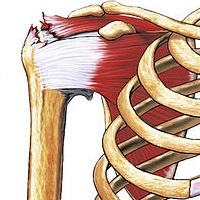| Musculoskeletal injury | |
|---|---|
 | |
| A rotator cuff tear injury results in the muscles, ligaments and tendons being disturbed which in-turn restricts regular movement. | |
| Specialty | Physiotherapy |
| Symptoms | Mild to severe aches and pains, numbness, weakness, tingling and atrophy |
| Complications | Loss of movement, disability |
| Duration | Dependent on injury, 2-10 weeks[1][2] |
| Types | Bone, muscle, ligament and tendons |
| Causes | overuse, incorrect posture, car accidents, high impact collisions |
| Risk factors | Long term disability |
| Diagnostic method | Pain and numbness |
| Prevention | Maintain correct posture, limit |
| Treatment | Heat and cold packs, immobilisation, rest |
| Deaths | Unknown |
Musculoskeletal injury refers to damage of muscular or skeletal systems, which is usually due to a strenuous activity and includes damage to skeletal muscles, bones, tendons, joints, ligaments, and other affected soft tissues.[3][4] In one study, roughly 25% of approximately 6300 adults received a musculoskeletal injury of some sort within 12 months—of which 83% were activity-related.[3] Musculoskeletal injury spans into a large variety of medical specialties including orthopedic surgery (with diseases such as arthritis requiring surgery), sports medicine,[5] emergency medicine (acute presentations of joint and muscular pain) and rheumatology (in rheumatological diseases that affect joints such as rheumatoid arthritis).
Musculoskeletal injuries can affect any part of the human body including; bones, joints, cartilages, ligaments, tendons, muscles, and other soft tissues.[1] Symptoms include mild to severe aches, low back pain, numbness, tingling, atrophy and weakness.[1][2] These injuries are a result of repetitive motions and actions over a period of time.[6] Tendons connect muscle to bone whereas ligaments connect bone to bone.[7] Tendons and ligaments play an active role in maintain joint stability and controls the limits of joint movements, once injured tendons and ligaments detrimentally impact motor functions.[2][8] Continuous exercise or movement of a musculoskeletal injury can result in chronic inflammation with progression to permanent damage or disability.[9]
In many cases, during the healing period after a musculoskeletal injury, a period in which the healing area will be completely immobile, a cast-induced muscle atrophy can occur. Routine sessions of physiotherapy after the cast is removed can help return strength in limp muscles or tendons. Alternately, there exist different methods of electrical stimulation of the immobile muscles which can be induced by a device placed underneath a cast, helping prevent atrophies[10] Preventative measures include correcting or modifying one's postures and avoiding awkward and abrupt movements.[1] It is beneficial to rest post injury to prevent aggravation of the injury.[11]
There are three stages of progressing from a musculoskeletal injury; Cause, Disability and Decision.[12] The first stage arises from the injury itself whether it be overexertion, fatigue or muscle degradation.[12] The second stage involves how the individual's ability is detrimentally affected as disability affects both physical and cognitive functions of an individual.[12][9] The final stage, decision, is the individual's decision to return to work post recovery as Musculoskeletal injuries compromise movement and physical ability which ultimately degrades one's professional career.[12]
- ^ a b c d Siegel, Jerome H. (October 2007). "Risk of Repetitive-Use Syndromes and Musculoskeletal Injuries". Techniques in Gastrointestinal Endoscopy. 9 (4): 200–204. doi:10.1016/j.tgie.2007.08.010.
- ^ a b c Pascarelli, Emil F (2004). Dr. Pascarelli's complete guide to repetitive strain injury what you need to know about RSI and carpal tunnel syndrome. Hoboken, N.J: John Wiley & Sons. p. 23. ISBN 9780471656197.
- ^ a b Hootman, Jennifer M.; Macera, Carol A.; Ainsworth, Barbara E.; Addy, Cheryl L.; Martin, Malissa; Blair, Steven N. (May 2002). "Epidemiology of musculoskeletal injuries among sedentary and physically active adults". Medicine & Science in Sports & Exercise. 34 (5): 838–844. doi:10.1097/00005768-200205000-00017. PMID 11984303.
- ^ Gimigliano, Francesca; Resmini, Giuseppina; Moretti, Antimo; Aulicino, Milena; Gargiulo, Fiorinda; Gimigliano, Alessandra; Liguori, Sara; Paoletta, Marco; Iolascon, Giovanni (2021-10-17). "Epidemiology of Musculoskeletal Injuries in Adult Athletes: A Scoping Review". Medicina (Kaunas, Lithuania). 57 (10): 1118. doi:10.3390/medicina57101118. ISSN 1648-9144. PMC 8539527. PMID 34684155.
- ^ Koutras, Christos; Buecking, Benjamin; Jaeger, Marcus; Ruchholtz, Steffen; Heep, Hansjoerg (November 2014). "Musculoskeletal Injuries in Auto Racing: A Retrospective Study of 137 Drivers". The Physician and Sportsmedicine. 42 (4): 80–86. doi:10.3810/psm.2014.11.2094. PMID 25419891. S2CID 22425278.
- ^ Wardle, Sophie L.; Greeves, Julie P. (November 2017). "Mitigating the risk of musculoskeletal injury: A systematic review of the most effective injury prevention strategies for military personnel". Journal of Science and Medicine in Sport. 20: S3–S10. doi:10.1016/j.jsams.2017.09.014. PMID 29103913.
- ^ Crouch, Robert; Charters, Alan; Dawood, Mary; Bennett, Paula, eds. (2016). "Musculoskeletal injuries". Oxford Handbook of Emergency Nursing (2nd ed.). Oxford University Press. doi:10.1093/med/9780199688869.003.0009. ISBN 978-0-19-176805-7.
- ^ Frievalds, A. (2011). Biomechanics of the Upper Limbs : Mechanics, Modeling and Musculoskeletal Injuries, Second Edition (2nd edition.). Boca Raton, FL: CRC Press, an imprint of Taylor and Francis.[page needed]
- ^ a b Booth-Kewley, Stephanie; Schmied, Emily A.; Highfill-McRoy, Robyn M.; Sander, Todd C.; Blivin, Steve J.; Garland, Cedric F. (June 2014). "A Prospective Study of Factors Affecting Recovery from Musculoskeletal Injuries". Journal of Occupational Rehabilitation. 24 (2): 287–296. CiteSeerX 10.1.1.995.7437. doi:10.1007/s10926-013-9456-7. PMID 23797182. S2CID 2199186.
- ^ "Casting new energy onto broken limbs - ISRAEL21c". www.israel21c.org. Archived from the original on 2008-10-05.
- ^ Podlog, Leslie; Wadey, Ross; Stark, Andrea; Lochbaum, Marc; Hannon, James; Newton, Maria (July 2013). "An adolescent perspective on injury recovery and the return to sport". Psychology of Sport and Exercise. 14 (4): 437–446. doi:10.1016/j.psychsport.2012.12.005.
- ^ a b c d Stowell, Anna Wright; McGeary, Donald D. (2008). "Musculoskeletal Injury". In Schultz, Izabela Z.; Gatchel, Robert J. (eds.). Handbook of Complex Occupational Disability Claims: Early Risk Identification, Intervention, and Prevention. Springer. pp. 117–139. doi:10.1007/0-387-28919-4_6. ISBN 978-0-387-28919-9.